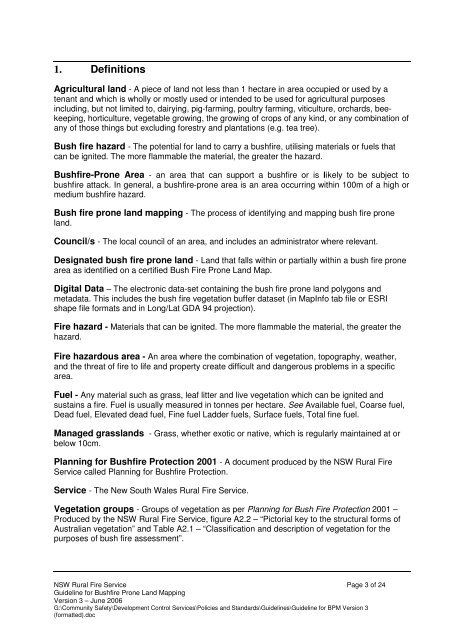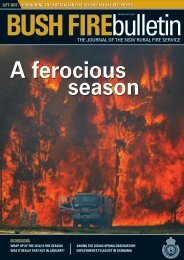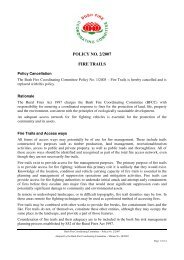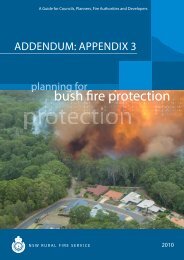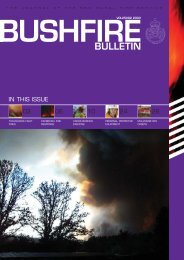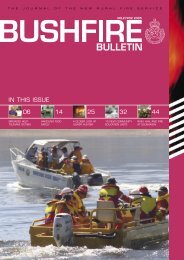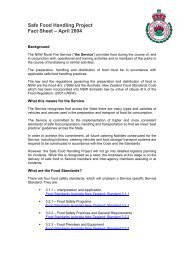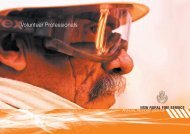GUIDELINE - NSW Rural Fire Service
GUIDELINE - NSW Rural Fire Service
GUIDELINE - NSW Rural Fire Service
You also want an ePaper? Increase the reach of your titles
YUMPU automatically turns print PDFs into web optimized ePapers that Google loves.
1. Definitions<br />
Agricultural land - A piece of land not less than 1 hectare in area occupied or used by a<br />
tenant and which is wholly or mostly used or intended to be used for agricultural purposes<br />
including, but not limited to, dairying, pig-farming, poultry farming, viticulture, orchards, beekeeping,<br />
horticulture, vegetable growing, the growing of crops of any kind, or any combination of<br />
any of those things but excluding forestry and plantations (e.g. tea tree).<br />
Bush fire hazard - The potential for land to carry a bushfire, utilising materials or fuels that<br />
can be ignited. The more flammable the material, the greater the hazard.<br />
Bushfire-Prone Area - an area that can support a bushfire or is likely to be subject to<br />
bushfire attack. In general, a bushfire-prone area is an area occurring within 100m of a high or<br />
medium bushfire hazard.<br />
Bush fire prone land mapping - The process of identifying and mapping bush fire prone<br />
land.<br />
Council/s - The local council of an area, and includes an administrator where relevant.<br />
Designated bush fire prone land - Land that falls within or partially within a bush fire prone<br />
area as identified on a certified Bush <strong>Fire</strong> Prone Land Map.<br />
Digital Data – The electronic data-set containing the bush fire prone land polygons and<br />
metadata. This includes the bush fire vegetation buffer dataset (in MapInfo tab file or ESRI<br />
shape file formats and in Long/Lat GDA 94 projection).<br />
<strong>Fire</strong> hazard - Materials that can be ignited. The more flammable the material, the greater the<br />
hazard.<br />
<strong>Fire</strong> hazardous area - An area where the combination of vegetation, topography, weather,<br />
and the threat of fire to life and property create difficult and dangerous problems in a specific<br />
area.<br />
Fuel - Any material such as grass, leaf litter and live vegetation which can be ignited and<br />
sustains a fire. Fuel is usually measured in tonnes per hectare. See Available fuel, Coarse fuel,<br />
Dead fuel, Elevated dead fuel, Fine fuel Ladder fuels, Surface fuels, Total fine fuel.<br />
Managed grasslands - Grass, whether exotic or native, which is regularly maintained at or<br />
below 10cm.<br />
Planning for Bushfire Protection 2001 - A document produced by the <strong>NSW</strong> <strong>Rural</strong> <strong>Fire</strong><br />
<strong>Service</strong> called Planning for Bushfire Protection.<br />
<strong>Service</strong> - The New South Wales <strong>Rural</strong> <strong>Fire</strong> <strong>Service</strong>.<br />
Vegetation groups - Groups of vegetation as per Planning for Bush <strong>Fire</strong> Protection 2001 –<br />
Produced by the <strong>NSW</strong> <strong>Rural</strong> <strong>Fire</strong> <strong>Service</strong>, figure A2.2 – “Pictorial key to the structural forms of<br />
Australian vegetation” and Table A2.1 – “Classification and description of vegetation for the<br />
purposes of bush fire assessment”.<br />
<strong>NSW</strong> <strong>Rural</strong> <strong>Fire</strong> <strong>Service</strong> Page 3 of 24<br />
Guideline for Bushfire Prone Land Mapping<br />
Version 3 – June 2006<br />
G:\Community Safety\Development Control <strong>Service</strong>s\Policies and Standards\Guidelines\Guideline for BPM Version 3<br />
(formatted).doc


